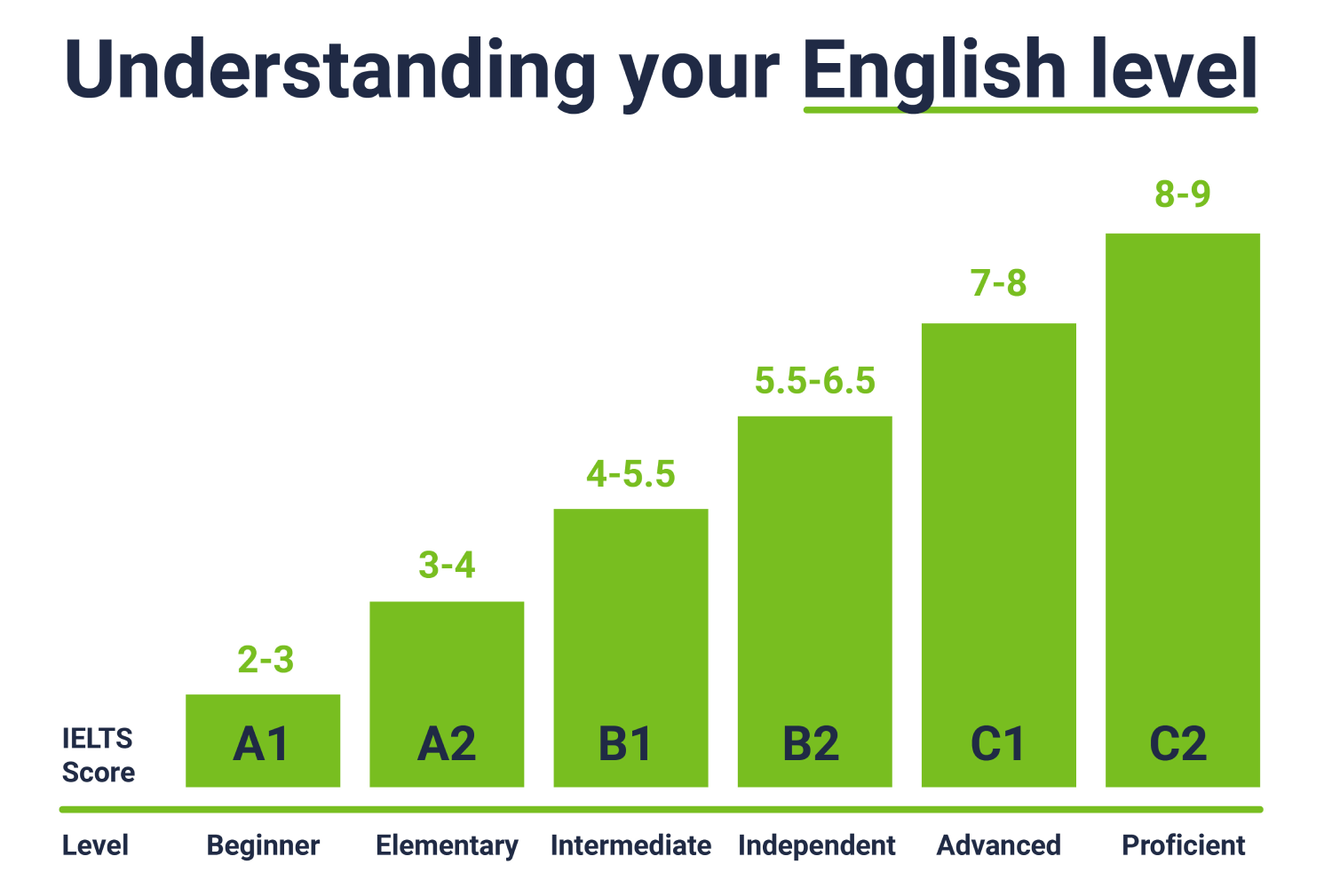The CEFR also helps educational institutions and employers assess a candidate’s language qualification for admission or job opportunities. Its main goal is to offer a common framework for teaching and evaluating language skills across all European languages.
Imagine applying to your dream university, but the admission requirement asks for a B1 or B2 level of language proficiency. What are these letters and numbers and why do they seem to appear on every university application, job advert or internship listing?
This is what we are going to understand in this blog. These alphabet codes are not random. They belong to the (Common European Framework of Reference for Languages) CEFR English levels, a global standard that defines how well you can use and understand a language.
Here at English Path, we are experts in language learning. In this article, we spoke to Daniel to break down what the English language levels A1 to C2 truly mean, how they measure your language ability, and why institutions and employers rely so heavily on this system to evaluate English proficiency.
Let’s find out.
What is CEFR and English proficiency level?
The Common European Framework of Reference for Languages (CEFR) was developed by the Council of Europe in 1990. It serves as an international standard for describing language proficiency. The framework is not only for English; it can be applied to any language. The CEFR breaks down what learners can do in reading, writing, listening and speaking at each stage of their language journey.

CEFR is divided into three broad categories:
- A Level (Basic user): Split into A1 and A2, where learners are at beginner or elementary stages.
- B Level (Independent user): Split into B1 and B2, where learners can handle practical communication with growing confidence.
- C Level (Proficient user): Split into C1 and C2, where learners demonstrate advanced and near-native proficiency.
The CEFR aims to provide a common scale for comparing an individual’s English proficiency level globally. For example, a B2 student in Spain should have similar skills to a B2 student in Japan. Schools, universities and employers use CEFR to set entry requirements or design language courses that match learner needs.
Each level outlines specific skills in reading, writing, speaking, and listening. Let us explore these levels in detail:
A1 English level: The beginner
What is A1 English level?
The A1 level represents the starting point for English learners. At this level, learners can:
- Understand and use basic phrases and expressions.
- Introduce themselves and ask simple questions like ‘Where do you live?’ or ‘Do you like football?’.
- Interact in a very basic way, provided the other person speaks slowly and clearly.
Daniel Berejnoi, Director of Studies at EP Dublin, told us, “A1 learners are just beginning to explore the language. They might be able to produce a few isolated words or very simple phrases, but they’re still developing the core skills needed to engage in basic conversations.”
Skills at A1 Level:
- Recognising common words and phrases.
- Writing simple sentences like ‘My name is John’.
- Following slow and clear speech.
- Imagine you are travelling to an English-speaking country and need to ask for directions or order food at a restaurant. At the A1 level, you can manage these tasks with basic phrases.
This is the starting point for many international learners. Students at A1 may struggle with grammar and vocabulary, but they can build confidence by practicing real-life situations.
A2 English level: The elementary
At the A2 English level, learners gain more confidence in everyday communication. They can:
- Understand frequently used expressions related to personal information, shopping and family.
- Communicate in simple and routine tasks where direct information exchange is required.
- Describe their background and environment in simple terms.
Daniel explained, "A2 learners can usually handle small talk fairly well. They perform well at simple, everyday interactions if the other person speaks slowly and clearly. They’re just starting to build confidence with familiar topics but still rely heavily on memorised phrases and basic structures."
This English proficiency level shows real progress compared to A1. A2 learners can survive in simple travel or work contexts, though extended conversations are still demanding.
Try a free test to check your English proficiency
Take test nowB1 English level: The intermediate
A1 and A2 lay the foundation for higher English language levels. Without building a solid base here, moving on to B levels can become overwhelming.
Daniel highlighted that “B1 learners are becoming more independent in their use of the language. They can manage routine conversations and express opinions on familiar subjects, though they may struggle with more complex or abstract ideas."
The B1 level allows learners to:
- Understand the main points of clear speech on familiar matters such as school, work and travel.
- Deal with most situations while travelling.
- Produce simple connected text on topics of personal interest.
- Describe experiences, events and express hopes or ambitions.
B1 represents a turning point, as learners begin to think in English rather than translating every phrase from their own language. However, their vocabulary may still feel limited and they need more practice with grammar accuracy.
B2 English level: The upper-intermediate
The B2 English level is a significant milestone. It is also considered the threshold for advanced English. Learners can:
- Understand the main ideas of complex texts.
- Interact with native speakers fluently enough that neither side needs to slow down too much.
- Produce clear, detailed texts and explain their point of view on various issues.
Daniel added, "B2 learners are generally comfortable communicating in a range of situations. They can express themselves clearly and in some detail, even if occasional errors or gaps in vocabulary still occur, especially with more complicated topics."
In real life, a B2 learner can attend lectures in English, join workplace discussions or take part in social activities without difficulty. Many English-language universities and employers set B2 as the minimum requirement.
C1 English level: The advanced
Learners at C level are considered highly proficient. They are not only capable of managing communication, but they can also use the language in sophisticated and flexible ways.
Elaborating on higher proficiency levels, Daniel explained, “C1 learners have a strong command of the language and can use it flexibly and effectively for social, academic, and professional purposes. They can understand implicit meaning and adapt their language to different contexts with ease."
At the C1 English level, learners can:
- Understand a wide range of demanding texts and recognise implicit meaning.
- Express themselves fluently without much searching for words.
- Use language effectively for social, academic and professional purposes.
- Produce clear, well-structured and detailed writing on complex subjects.
A C1 speaker can follow academic lectures, write detailed reports or join debates with confidence. At this stage, English is not a barrier but a tool for expressing higher-level thinking. For example, you can deliver a presentation at work or discuss abstract topics like philosophy.
C2 English level: The proficiency
What is the C2 English level?
The C2 level represents near-native proficiency. It is the highest of the CEFR English levels.
Learners can:
- Understand everything heard or read with ease.
- Summarise information from different spoken or written sources and reconstruct related arguments.
- Express themselves spontaneously and precisely.
"C2 learners have mastered the language to an exceptional degree. They can understand and produce complex, nuanced language effortlessly, and communicate with precision and subtlety in virtually any context.", explained Daniel.
This English proficiency level is close to a native command of the language. While even native speakers may not know every word in the dictionary, a C2 learner is able to function at that level in both professional and academic settings.
Why understanding CEFR English levels matters
Knowing your place on the CEFR scale is not only about the examinations or certificates. It gives you a realistic picture of your current strengths and weaknesses. It helps you set learning goals and shows how much progress you need to make to reach that goal.
CEFR is characterised by its simplicity. A single letter and number combination explains clearly what someone can do with English, no matter where in the world they studied.
Achieve your language proficiency with English Path
From A1 beginners who are just learning to build short sentences, to C2 masters who use English almost like native speakers, the CEFR framework covers every stage of learning. It is a practical guide for learners, teachers, employers and institutions worldwide.
Language learning is not only about reaching a final level but enjoying the journey step by step. With CEFR, that journey is clearly marked, helping every learner navigate from beginner to mastery with confidence.
At English Path, we understand that every learner's journey is unique. Our courses are designed to cater for all English proficiency levels, from A1 to C2. Whether you are a beginner looking to start your journey or an advanced learner aiming for mastery, we have the right programme for you.
Ready to take your English skills to the next level?
Explore our coursesFAQs about CEFR English level
Does CEFR apply to all languages?
While CEFR serves as a worldwide standard for describing English language levels, another common measure is the International English Language Testing System (IELTS). IELTS is required by many universities and immigration departments worldwide, especially in English-speaking countries such as the UK, Australia, Canada and New Zealand.
Fluent English corresponds to C1 on the CEFR scale. At C1, a speaker can express ideas fluently and spontaneously without obvious word searching. C2 represents proficiency or mastery, where a speaker can use English effortlessly, understand everything, and handle a complex, nuanced language.
Why should I join English Path for IELTS preparations?
English Path gives you the edge to achieve your target score. Our experienced trainers provide personalised guidance, focused practice on all four skills and proven strategies to tackle the exam confidently. With small, interactive classes, flexible learning options and a results-driven approach, you will build the skills and confidence to succeed in IELTS faster and more effectively.
Is C2 level the same as being a native speaker?
Not exactly, but C2 indicates near-native proficiency. A learner at this level can understand complex ideas, express themselves clearly and function academically or professionally in English.

